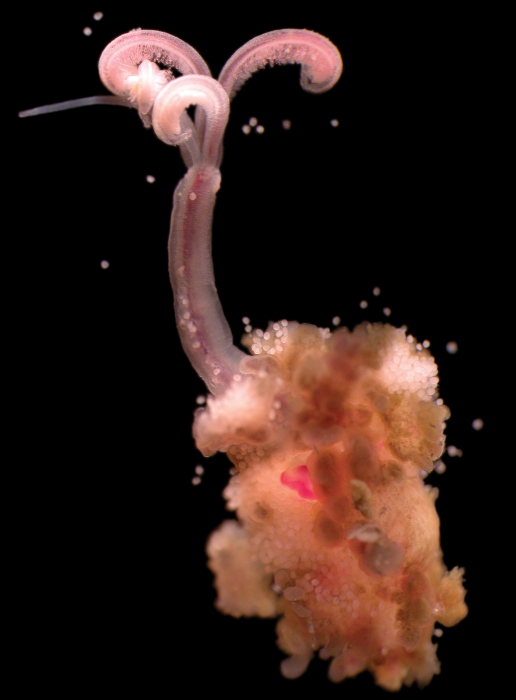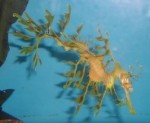Earlier this week, Fox News commentator and all-around terrific guy* Erick Erickson, while discussing a recent Pew Study that revealed that women were the sole breadwinners in 40% of US households that contain children, had this to say:
“I’m so used to liberals telling conservatives that they’re anti-science. But liberals who defend this and say it is not a bad thing are very anti-science. When you look at biology—when you look at the natural world—the roles of a male and a female in society and in other animals, the male typically is the dominant role. The female, it’s not antithesis, or it’s not competing, it’s a complementary role.”
I’m not sure where Erickson got his science education from, but it’s pretty clear he should have spent a little more time shopping around on the free market, because he sure is wrong. How wrong? I managed to assemble this list of 10 marine species with dwarf, parasitic, or otherwise reduced males (including an entire female-only class) while waiting for my toast**. So have a seat and let me show you how much weirder and more wonderful the world is than Erickson’s Disney-esque misinterpretation of biology.
1. Anglerfish
The deep-sea Anglerfish is among the most common examples of parasitic males in the marine world. Anglerfish comprise a variety of taxa in the order Lophiiformes. Almost all (females) possess a specialized appendage that acts as a lure to attract unwary prey. Life in the deep sea is rough–even though it is the largest and most diverse ecosystem on Earth, biomass is fairly low–so finding a mate is a struggle for these slow swimming fishes. The solution: carry your partner with you.
Male anglerfish are tiny, often less than 5% the size of the female, but they possess powerful olfactory receptors, allowing them to seek out females. Once a mate is located, the male anglerfish latches on to her abdomen, fuses his circulatory system with hers, and is then slowly digested until there’s nothing left but a sac of gonads surrounded by basic life-supporting tissues. Female anglerfish are not monogamous, either. At any given time she could be covered by a half-dozen parasitic males. Kinky.

2. Bone-eating snot-worms
Readers of this blog are no doubt familiar with everybody’s favorite bone-eating, snot-flower worm and her harem of dwarf males. Osedax, a genus only discovered in the last decade, had risen to prominence as one of the major contributors to whale fall communities. Finding a dead whale in the deep sea, it turns out, isn’t much easier than finding a mate, so once a whale fall is settled, Osedax need to maximize their reproductive output before the food runs out. Several species of Osedax solve this problem by nurturing harems of parasitic dwarf males in their trunks. One study counted 111 males nestled inside the tube of a single Osedax female.
3. Bdelloid Rotifers
When I first wrote about rotifers in my super powered organism post, I compared them to Rogue from the X-Men, since they have the ability to absorb genetic materials from other species and acquire their abilities. I could have just as easily compared them to Wonder Woman, since, like the Amazons of Themiscyra, bdelloid rotifers decided that men just aren’t for them. The entire class excised males from their gene pool 80 million years ago.
The evolution of sexual reproduction was a pretty major step forward in terms of increasing genetic diversity. While there are plenty of species that still reproduce asexually, there are very few that developed sexual reproduction and then subsequently lost it. The ability to incorporate genetic material from their surroundings may be a strategy for maximizing genetic diversity in lieu of genetic recombination through sexual reproduction.
4. Blue Whales (and many other whales)
You might think, if you adhered to a particularly toxic narrative of masculinity, that possessing the largest penis that has ever existed might place you at the pinnacle of your social hierarchy. Such is not the case for the Blue Whale, where sexual dimorphism favors the female. Female Blue Whales are, on average, 2 meters longer than their male compatriots. While little is known about Blue Whale social behavior, many other whale species form matriarchal pods. The core social group for killer whales is the matrilineal group (a collective of females and their offspring, often 3 generations deep). Sperm whales also form matriarchal pods, comprised of females and juveniles of both sexes, while bull sperm whales are either solitary or form small bachelor herds.
5. Goose Barnacles
Can hermaphrodite species also have dwarf males? If they’re goose barnacles they can! Scalpellum scalpellum is a barnacle that is usually a hermaphrodite. However, when environmental conditions are right and the concentration of adult barnacles is dense, larvae that settle on already developed barnacles, will, instead of assuming both sexes, becomes dwarf males. Interestingly, while all S. scalpellum larvae have the potential to become hermaphrodites, only 50% are able to become exclusively male.
6. Mole Crabs
Wander along a sandy beach on the Atlantic coast and you will, undoubtedly encounter a wonderful little creature called the mole crab. Sometimes called sand crabs or sand fleas depending on where you are from, anomurans in the genus Emerita are fascinating creatures that hold a very special place in my heart (my first scientific paper was on the circatidal rhythms of Emerita talpoida).
If you find a mole crab larger than a few centimeters, congratulations, you’ve found a female. If you have a good dissecting microscope and a little curiosity, you can lift up the telson and look for her reproductive gonpods. You may also notice a few small critters that many students first mistake for juvenile mole crabs. These are a special kind of dwarf male–neotenous males. Neotenous males retain many of their juvenile features. Among mole crabs, these neotenous males hang out beneath the female’s telson, close to her reproductive organs. Like the anglerfish, the females are not monogamous.
7. Oysters
Ostrea puelchana is a South American oyster with a reproductive strategy known as rhythmic successive hermphroditism. Larvae settle and, after about a year, become sexualy mature males. Then, as they continue to develop, they turn into hermaphrodites. Finally, they end their several year life as females. But not all Ostrea get to enjoy life as a rhythmic successive hermaphrodite. Once again, we’ve encountered a species with two, separate reproductive strategies. Ostrea puelchana also possess neotenous dwarf males.
These dwarf males only live for about a year, and they are only found attached to 17% of adult Ostrea. Unlike goose barnacles, it appears that the dwarf males can only reproduce with exclusively female individuals, not hermaphrodites. Interestingly, when adult density increases, the number of females decreases. So, in this case, a higher density of hermaphrodites is a reproductive advantage when the population is large–twice as many partners to spawn with–but when the population is small, having dedicated males attached to your shell increases the odds of successful reproduction.
8. Paper Nautilus
One of the great challenges in writing a good scientific paper is composing a title that is both informative, comprehensive, and compelling. The Drs. Knoflach and van Harten pulled off this hat-trick with their paper on Paper Nautilus reproduction: Tidarren argo sp. nov. (Araneae: Theridiidae) and its exceptional copulatory behaviour: emasculation, male palpal organ as a mating plug and sexual cannibalism.
Paper Nautlii are a fairly enigmatic species with a rather brutal reproductive cycle. The male nautilus has a gonopod–a reproductive tentacle–which is placed in contact with the female epigynum–an external gential structure. Upon contact, the female simply rips the gonopod off the male. The gonopod continues to function for several hours, during which time it acts as a genital plug, preventing other males from mating with her. Fortunately, the male doesn’t have to worry about regenerating his gonopod, since we have now reached the “sexual cannibalism” portion of the program.
9. Wood-boring Molluscs
Wood-boring molluscs are a group of bivalves that survive either directly or indirectly on wood decomposition. They can be found in both shallow and deep-sea ecosystems. For at least two species, the seagrass-dwelling Zachsia zenkewitschi and the deep-sea Xylophaga supplicata, they can also be found comfortably nestled in the pouches of other wood-boring molluscs. That’s right, once again we have some lovely parasitic dwarf males.
For Zachsia, the males enter the females as larvae, and then grow to maturity within specialized pouches. They are only about 1 mm long. Xylophaga has a more interesting story, since, at first discovery, it was presumed that these reduced males were actually juveniles being reared in a brood pouch, rare for a bivalve. It was only recently discovered (as in, this year) that these were actually dwarf males***.
10. Spoon Worms
The green spoonworm is one of those creatures that looks absolutely stunning on the seafloor, but quickly loses it aesthetics when brought to the surface. Bonellia viridis is an echiurin that lives in deep-sea sediment throughout the world. As a larvae, it is sexually undifferentiated, where it settles determines its sex. If the spoonworm larvae lands on the seafloor it becomes female and begins to secrete a potent toxin called bonellin. Should the larvae come in contact with this toxin, it will be masculinized and sucked into the spoonworm’s body through her feeding proboscis, where it will be absorbed into her genital sac and spend the rest of its life producing sperm.
Bonellin isn’t just used for sex determination, however. This chemical, which is also the cause of the spoonworm’s beautiful green coloration, is an incredibly potent biocide, capable of killing bacterial, animal larvae, and even red blood cells. Because this potent toxin is photosensitive, it’s currently being investigated for it’s potential as a targeted anti-tumor drug. Which means that, should it prove effective, one day we might attribute a successful cancer treatment to the sex lives of spoonworms.
So why are there some many different ways to be a parasitic or dwarf male and why are female dominated communities so common in the natural world? The general paradigm is that, evolutionarily males are cheap and females are expensive. Females tend to bear the brunt of energetically expensive processes such as producing eggs, gestation, and rearing offspring, while males only need to provide genetic material. With more social animals, like whales, females tend to be the only ones that can retain lineage fidelity–they know who their offspring are while most males don’t. Obviously, this isn’t true in all cases, since there are as many different ways to have sex as there are species that do it.
One thing is certain, when you look at biology—when you look at the natural world—the roles of a male and a female in society and in other animals, there is no such thing as a “typical role”.
*by terrific, I mean terrible
**seriously, this took 30 seconds, tops
***incidentally, I don’t have full access to this paper, so authors, if you want people to cover your research in detail rather than just saying “they found dwarf males”, publish open access.


Truly enjoyed the highly informative paper with a sense of humor that would make anyone want to learn more! Laughing out loud while reading biology is not of every day. Terrific job* *by that I mean extremely good, excellent.
I LOVE this post! I do presentations about reproduction in the ocean using several of these organisms as examples, and now I can add more species to my talk. Thanks for doing additional research for me!
I especially like the three star note. More public access!
Well said Andrew! And should the Erick Erickson-types take issue with the phylogenetically rather distant examples (nothing wrong with that as far as I’m concerned), please review the biology of the bonobo…
Why is it that pseudoscientists think it’s valid to cite other species’ behaviors to explain or ‘justify’ human behavior?
It’s funny, you don’t often see them cite the common nature of homosexuality among the sexually-reproducing animals in the same context… mysterious! 😉
Under normal circumstances, I would not presume to say “Andrew Thaler sure is wrong”. But since his thesis is that “Eric Erickson sure is wrong”, it seems he is begging to be called out as a liar and a political hack.
Male-female variation is the rule in nature. This blog emphasizes just that. Sexual variation in the higher species: humans, gorillas, etc. tends to favor males of greater size and muscle mass. Even if it this were not the most common pattern, it is provably true of humans.
When someone says something that is provably true, writing as satirical article like the one you wrote is both educational and interesting. But extending your opportunity to educate into an insult because of your narrow political bias is non-productive, and in this case, actually misleading.
A naive person might be misled to believe that female dominance is the rule in nature. It is not. Also misleading is the idea that it is good for society and good for individuals to push women into situations where they have to compete with men. I am not suggesting that anyone knows, truly, if this is a good or bad thing, but it is an idea that begs dispassionate examination.
Narrowly biased political hacks delivering snide malicious comments do not in any way advance this discussion. Your editor should have reigned you in, that he didn’t speaks ill of the whole journalist community.
Scott: Sounds you know something about the relative importance or contribution of male versus female genders apart from Homo sapiens. I get very excited when someone has a new theory on this subject, but your statement “male-female variation is the rule in nature” is a bit opaque. Please expound further. I’m also curious as to your take on “higher species.” What exactly are higher species (which ones are they, how did they reach such metaphorical heights, etc)? If male dominance is actually the rule in nature (or so I gather from your 4th paragraph), please elaborate!